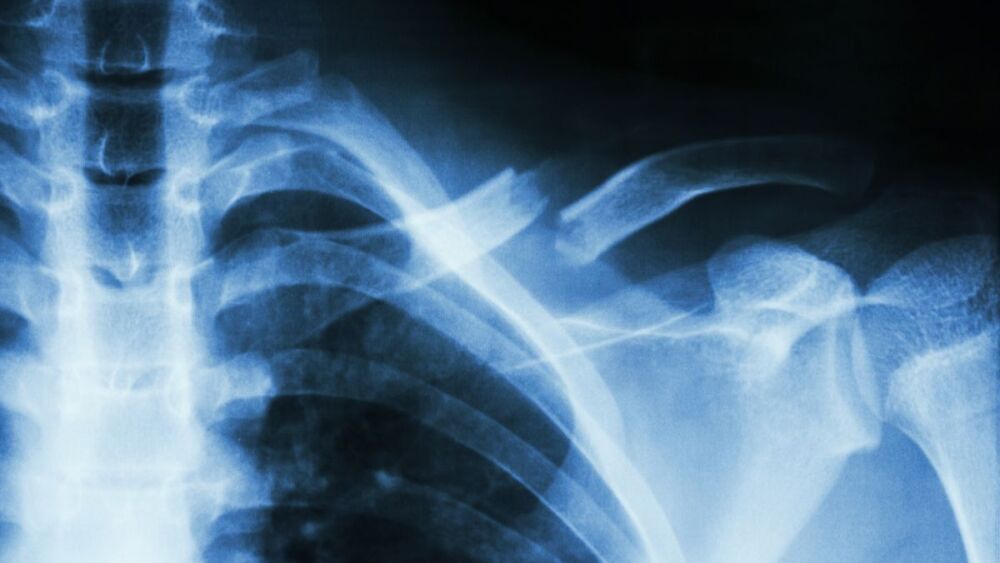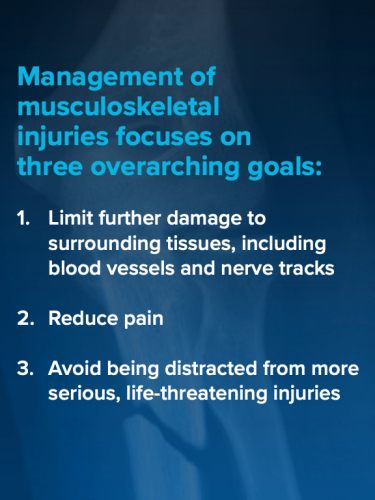This article originally appeared in the EMS1 Digital Edition, “Prehospital trauma: Today’s tenets for triage, treatment and transport.” Download the free special report here.
Treating broken bones and dislocations has been an important part of EMS as far back as EMS history goes. Early texts dedicated significant portions to applying splints, fashioning slings and tying swathes. Even today, initial EMT courses spend several hours using triangular bandages and board splints to immobilize extremity fractures.
Advances in technology and increased focus on the many medical maladies patients present with has not decreased the importance of managing musculoskeletal injuries. While many medical conditions may not worsen if treatment is put off until arrival at the hospital, the same cannot be said for fractures and dislocations. Without proper splinting and care prior to transport, injured patients may experience unnecessary pain, worsened soft tissue damage and permanent neurovascular deficit.
Management of musculoskeletal trauma begins with the same assessment priorities we give all trauma patients. Once scene safety is established, survey the scene for clues about the mechanism of injury (MOI) as you make your way to the patient. Understanding the MOI can help predict injuries the patient may have.
PRIMARY AND SECONDARY ASSESSMENT
Every patient should receive a quick primary survey for life-threatening injuries. The primary survey is not designed to identify musculoskeletal injuries except for severe bleeding. As always, treat life-threats when and where you find them. If severe bleeding is present, direct pressure will most likely be effective, but providers should be comfortable moving to wound packing or tourniquet application as needed if the bleeding is not controlled quickly.
The secondary survey is based on the MOI, patient complaint and findings of the primary survey, and may include a complete head-to-toe physical assessment or a more focused examination. Uncover and visualize areas of concern for any obvious deformities, bruising or swelling that might be an indication of fractures or for soft tissue injuries such as abrasions and lacerations that could be a clue to underlying damage.
Next, gently palpate the area for tenderness, deformity, instability or crepitus. Crepitus is a sound or feeling created when damaged bones and tissues grate together. It is a distinct feeling often described as unpleasant and unforgettable once experienced. Differentiate tenderness from pain as tenderness is experienced when an injured area is palpated or moved, while pain is a term reserved for what the patient feels when there is no intervention or touch by the EMS provider.
Assessment of distal circulation, motor and sensory functions (CMS) is critical when managing limb trauma. Checking for circulation generally means checking the most distal pulse possible, which would be the radial or ulnar pulses in the upper extremities and the dorsalis pedis or posterior tibial pulses in the lower extremities. Capillary refill time may be substituted when the fingers or toes are injured. While checking pulses, also be on the lookout for signs of growing hematomas, which indicate ongoing internal hemorrhage and risk for compartment syndrome.
Checking for motor and sensory function can be more detailed, to check specific nerve tracks. For example, a thorough upper extremity examination can include evaluation of the radial, ulnar and median nerves. This involves having the patient move their hands and fingers in specific patterns as well as checking for sensation and abnormal feelings in designated areas of the extremity.
In most cases, though, checking for gross neurologic functioning is sufficient. For example, for an arm injury, have the patient open and close their fist and gauge their overall strength by having them squeeze your fingers. Gross leg motor capability can be assessed by having the patient wiggle their toes and then push and pull against your hand with their feet. Gross sensation checks include noting any changes in or loss of sensation at the most distal portion of the extremity.
MANAGING MUSCULOSKELETAL INJURIES
Approaching the patient with a standardized and intentional primary and secondary survey will help to avoid letting painful and sometimes visually gruesome musculoskeletal injuries from distracting the EMS provider from life-threatening injuries. Don’t be complacent and assume an arm fracture is just an arm fracture.
Immobilization of the injured area will help accomplish the other goals of limiting pain and reducing further damage. Patients will usually self-splint, simply because movement leads to pain, but EMS should provide additional immobilization to limit movement during transportation to the ambulance and to the hospital.
In most cases, limbs are ideally splinted in the position of function or normal anatomic alignment. Especially if circulation or neurological functions are compromised, the limb should be gently repositioned if found deformed. This may require administration of pain medications prior to any movement. Reassess CMS after any movement.
Splinting materials may include:
- Cravats and padded board splints
- Vacuum splints
- Formable foam splints
- Ladder or other formable splints
- Pillows and other improvised materials
Proper splint application should avoid tight circumferential pressure and leave some surface of the limb visible for ongoing assessment of CMS and swelling.
Additional pain control measures should be considered after the splinting is completed including ice packs, elevation and additional doses of analgesic medications. Depending on local protocols, these medications may include opioids, ketamine, acetaminophen and non-steroidal anti-inflammatory drugs (NSAIDs).
In some cases, such as major trauma, specific efforts to splint extremity injuries may not be indicated. These are situations where use of a long backboard to simply immobilize the entire patient for quick transport are appropriate.
Transportation considerations
The transport destination decision for musculoskeletal trauma patients is based on local protocols and the capabilities of the receiving hospitals available in the region. Many of the injuries EMS providers will see can be appropriately cared for at local hospitals, even those without orthopedic surgeon coverage. In many instances, orthopedic injuries are initially assessed and stabilized by emergency physicians and then referred to specialists at a later date. Unless the injuries are unstable or involve circulatory or neurological compromise, it is better to allow the initial swelling to subside before definitive assessment and treatment.
Patients with musculoskeletal trauma require EMS providers to use a number of core skills including assessment, splinting, pain control and general patient management. Proper management is required to make the patients more comfortable and reduce the chance of further harm. It is a chance for EMS make a measurable difference in our patients’ experiences and outcomes.















